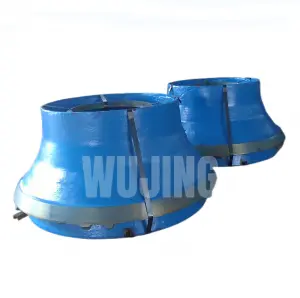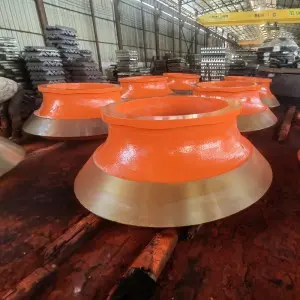Among the core components of fine grinding equipment, bowl-shaped liners, with their unique curved surface structure and functional design, have become key accessories for controlling the fineness of materials and enhancing grinding efficiency. From the micron-level grinding of ceramic raw materials to the ultra-fine powder processing in the pharmaceutical industry, bowl-shaped liners ensure that the final product meets strict particle size standards by guiding the movement trajectory of materials and optimizing the mode of action of grinding media. This article analyzes the structural principle, design details and technical advantages of bowl-shaped liners in precision grinding scenarios.
Curved surface structure: Guides materials to achieve uniform grinding
The “bowl-shaped” design of the bowl-shaped liner is not merely a simple choice of form, but is based on scientific calculations in fluid mechanics and grinding dynamics. Its inner wall has a parabolic or hemispherical arc (the radius of curvature is usually 1/3 to 1/2 of the diameter of the mill). When the material enters the discharge end from the mill cylinder, the curved surface can naturally guide the material to form a spiral upward movement trajectory, extending the grinding path by more than 30%. This design avoids the “material short circuit” problem that is prone to occur in flat gaskets – that is, some materials are directly discharged without being fully ground, thereby increasing the product particle size qualification rate to over 95%.
In terms of pressure distribution in the grinding chamber, the bowl-shaped structure converts the impact force of the grinding medium (steel balls, ceramic beads) into a uniform squeezing force through the curvature of the curved surface. When dealing with brittle materials such as quartz sand and alumina, this pressure distribution ensures uniform force on the material particles, reducing overgrinding (the proportion of fine powder can be controlled within 5%). For tough materials (such as talcum powder and graphite), the grinding time is extended to ensure that the fibrous particles are fully cut off. Practical data from a certain ceramic factory shows that after adopting bowl-shaped liners, the particle size deviation of glaze grinding was reduced from ±2μm to ±0.5μm, significantly enhancing the glossiness of the glaze surface.
Surface texture: Fine scales for regulating grinding intensity
The surface texture of the bowl-shaped liner serves as an “invisible knob” for controlling grinding efficiency and precision. Different texture designs are adapted to specific materials and grinding requirements. Radial grooves (with a depth of 0.5-2mm and a spacing of 5-10mm) are suitable for high-viscosity materials (such as ceramic slurry). The grooves can break the surface tension of the materials, prevent agglomeration, and at the same time guide the grinding media to form a directional impact flow, increasing the grinding efficiency by 25%. The helical texture is more suitable for dry grinding (such as the crushing of traditional Chinese medicine in the pharmaceutical industry). By controlling the material flow rate through the helical propulsion force and combining with the interlaced convex edges, a “shear-grinding” compound effect is formed, increasing the specific surface area of the powder by 15-20%.
The precision control of texture directly affects the grinding effect. In the silicon powder grinding of the microelectronics industry, the surface of the liner is laser-engraved with micron-level textures (with an accuracy of ±0.01mm), ensuring that each silicon powder particle can come into contact with the grinding medium. In the calcium carbonate grinding of architectural coatings, the rough casting texture (surface roughness Ra=5-8μm) can rapidly reduce the particle size of the material by increasing the friction force. In addition, the wear rate of the texture needs to match that of the grinding medium – when the surface of the liner wears down by 0.1mm, the texture function still remains above 80%. This “fault-tolerant design” extends the replacement cycle to over 800 hours.
Material selection: Balance wear resistance and grinding cleanliness
The material of bowl-shaped gaskets must simultaneously meet the dual requirements of “high wear resistance” and “low pollution”, and the selection criteria vary significantly across different industries. In the ceramic and chemical industries, high alumina ceramic gaskets (Al₂O₃ content > 92%) are the mainstream choice. They have a Mohs hardness of 9, and their wear resistance is ten times that of ordinary cast iron. Moreover, they do not introduce metal impurities into the material, ensuring the whiteness of the ceramic body and the purity of the chemical raw materials. Data from a certain alumina factory shows that after using ceramic bowl-shaped liners, the iron content in the product dropped from 0.03% to 0.005%.
Metal bowl-shaped gaskets (such as high-chromium cast iron) are suitable for the rough grinding stage of high-hardness materials (such as corundum and silicon carbide). Their surfaces can be quenched (hardness HRC55-60). When processing materials with particle sizes greater than 5mm, their service life is more than three times that of ceramic gaskets.
Anti-blocking design: A key detail to ensure continuous production
The accumulation and blockage of materials at the discharge end is a common problem affecting the continuity of grinding. The bowl-shaped liner solves this problem from the source through structural optimization. The edge of the liner is designed with an inclination Angle of 5-10°, and in combination with the annular flow guide groove at the bottom (with a width of 10-15mm), the material naturally flows towards the discharge port under the dual action of gravity and centrifugal force. When handling high-moisture materials (such as coal slime and kaolin), the clogging rate is reduced by more than 90%.
In the grinding of materials prone to scaling (such as gypsum and salts), the surface of the liner is coated with a hydrophobic coating (such as a modified polytetrafluoroethylene coating), which reduces the adhesion of the material by 60%. Combined with periodic reverse air flow purging (through the reserved pores of the liner), continuous 720-hour operation without cleaning can be achieved. Some pads are integrated with ultrasonic vibration devices. In the grinding of crystalline materials in the pharmaceutical industry, high-frequency vibration (20-30kHz) is used to prevent crystal deposition on the surface, ensuring a stable particle size distribution of the product.
The technical value of the bowl-shaped liner lies in transforming “precision grinding” from an abstract requirement into a quantifiable and controllable physical process. Its structural design determines the movement law of materials, surface texture regulates the grinding intensity, and material selection ensures product purity. The synergistic effect of the three makes it an irreplaceable core accessory in the field of fine grinding. For equipment users, choosing the appropriate bowl-shaped liner based on the material characteristics and grinding targets not only enhances the stability of product quality but also reduces grinding energy consumption by 30-40%, achieving dual benefits of “precision” and “efficiency”.
Post time: Jul-17-2025


